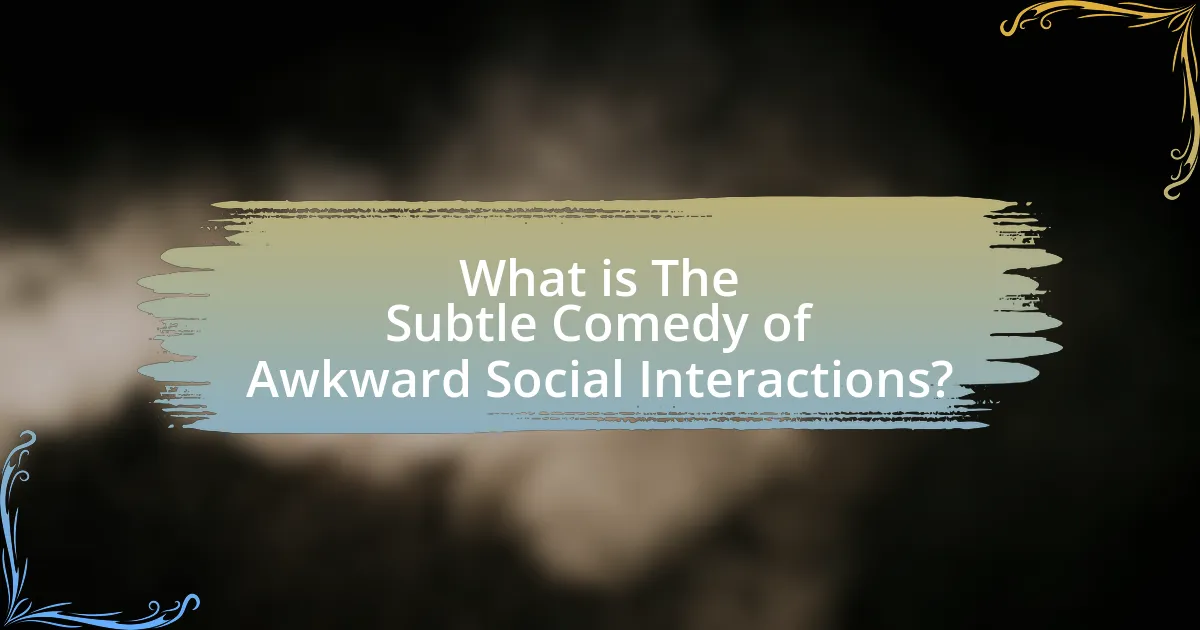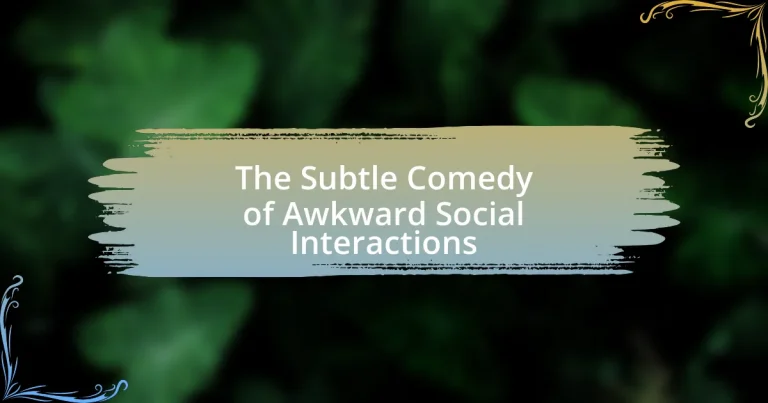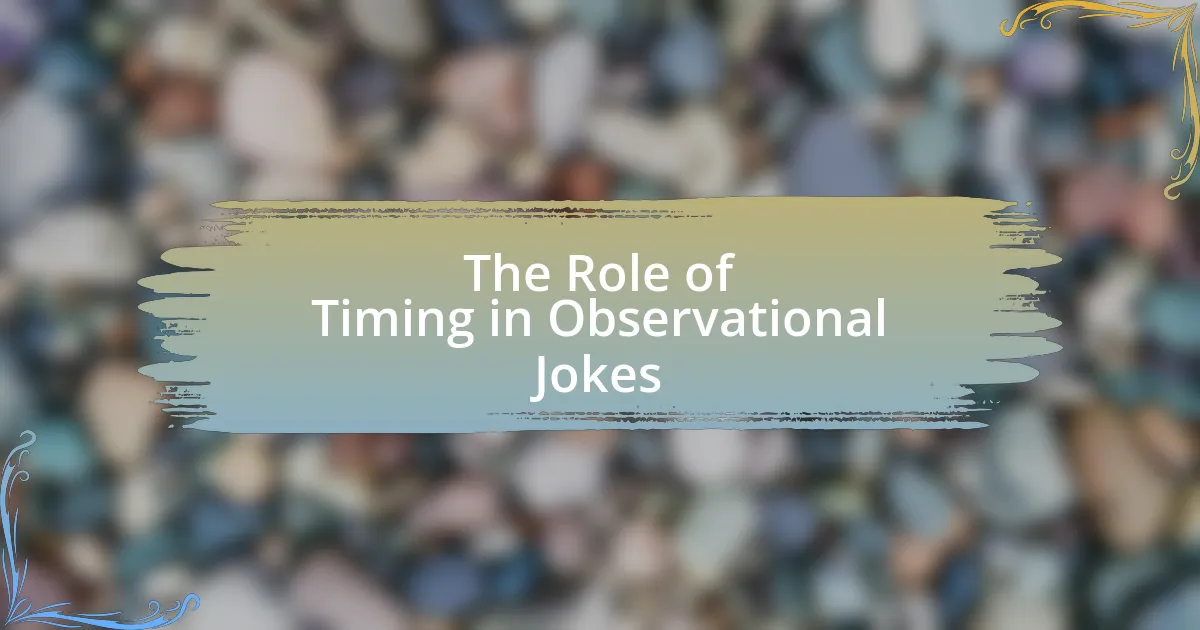The article explores the subtle comedy of awkward social interactions, emphasizing the humorous elements that arise from uncomfortable exchanges between individuals. It discusses how awkwardness highlights the incongruities between social expectations and actual behavior, leading to laughter as a coping mechanism. Key psychological factors contributing to this humor include incongruity, social norms violation, and relief theory. The article also examines the influence of cultural contexts on the perception of awkwardness, common scenarios that trigger such feelings, and the varying responses of different personality types. Additionally, it addresses the importance of timing in comedic interactions and offers strategies for effectively navigating awkward situations through humor and active listening.

What is The Subtle Comedy of Awkward Social Interactions?
The subtle comedy of awkward social interactions refers to the humorous aspects that arise from uncomfortable or clumsy exchanges between individuals. This type of comedy often highlights the discrepancies between social expectations and actual behavior, creating a relatable and entertaining experience for observers. Research indicates that such interactions can evoke laughter due to their unexpected nature and the shared human experience of social discomfort, as noted in studies on social psychology and humor, such as those by Peter McGraw and his colleagues, who explore the incongruity theory of humor.
How do awkward social interactions create comedic moments?
Awkward social interactions create comedic moments by highlighting the incongruities and discomfort inherent in human communication. These interactions often involve misunderstandings, social faux pas, or unexpected responses that deviate from social norms, eliciting laughter as a coping mechanism. Research indicates that humor often arises from the violation of expectations, as seen in studies by Peter McGraw and his colleagues, who developed the Benign Violation Theory, which posits that humor occurs when a situation is simultaneously perceived as a violation of social norms and benign. This dual perception allows individuals to laugh at the awkwardness, transforming discomfort into comedy.
What psychological factors contribute to the humor in awkwardness?
The humor in awkwardness is primarily driven by incongruity, social norms violation, and relief theory. Incongruity arises when there is a mismatch between expectations and reality, leading to surprise and laughter. For example, when someone mispronounces a word in a serious setting, the unexpectedness can trigger humor. Social norms violation occurs when individuals behave in ways that contradict societal expectations, such as an inappropriate joke during a formal event, which can elicit laughter as a coping mechanism. Relief theory suggests that humor serves as a release of psychological tension, allowing individuals to alleviate discomfort in awkward situations. Research by Martin et al. (2003) in “The Psychology of Humor: An Integrative Approach” supports these factors, indicating that humor often emerges from the tension created by social interactions that deviate from the norm.
How do cultural contexts influence the perception of awkward social interactions?
Cultural contexts significantly influence the perception of awkward social interactions by shaping norms, values, and expectations regarding behavior. For instance, in collectivist cultures, such as Japan, maintaining harmony and avoiding confrontation is paramount, leading individuals to perceive awkwardness as a serious social faux pas. Conversely, in individualistic cultures like the United States, awkward interactions may be viewed more humorously, allowing for greater tolerance and even appreciation of social blunders. Research by Matsumoto et al. (2008) highlights that cultural dimensions, such as individualism versus collectivism, directly affect emotional expressions and interpretations, reinforcing how cultural backgrounds dictate the perception of social awkwardness.
Why is awkwardness considered a universal experience?
Awkwardness is considered a universal experience because it arises from common social situations where individuals feel uncertain or uncomfortable. This discomfort is often linked to the inherent complexities of human interactions, such as differing social norms, expectations, and the fear of judgment. Research indicates that nearly everyone has encountered moments of awkwardness, highlighting its prevalence across cultures and contexts. For instance, a study published in the journal “Emotion” by authors like Keltner and Haidt found that feelings of awkwardness are closely tied to social anxiety and the desire for social acceptance, reinforcing the idea that these experiences are shared among diverse populations.
What common scenarios lead to feelings of awkwardness?
Common scenarios that lead to feelings of awkwardness include social interactions where there is a lack of familiarity, such as meeting new people or attending events alone. These situations often create discomfort due to uncertainty about social norms and expectations. For instance, research indicates that individuals frequently experience awkwardness during first dates, job interviews, or public speaking engagements, where the pressure to perform well heightens anxiety. Additionally, situations involving misunderstandings or miscommunications, such as interrupting someone or forgetting a person’s name, can also trigger feelings of awkwardness. These scenarios are supported by psychological studies that highlight the role of social anxiety and the fear of negative evaluation in contributing to awkward social experiences.
How do different personality types respond to awkward situations?
Different personality types respond to awkward situations in distinct ways, influenced by their traits and coping mechanisms. For instance, extroverts often address awkwardness with humor or by engaging others to diffuse tension, as they thrive on social interaction. In contrast, introverts may withdraw or become silent, preferring to avoid confrontation and process the situation internally. Additionally, individuals with high emotional intelligence typically navigate awkward moments with empathy, seeking to understand others’ feelings and resolve discomfort. Conversely, those with lower emotional awareness might react defensively or dismissively, exacerbating the awkwardness. Research indicates that personality traits significantly shape social behavior, with studies showing that extroversion correlates with proactive social engagement, while introversion is linked to reflective responses in uncomfortable scenarios.
What role does timing play in the comedy of awkward interactions?
Timing is crucial in the comedy of awkward interactions as it determines the effectiveness of humor derived from discomfort. The precise moment an awkward silence occurs or an unexpected comment is made can amplify the comedic effect, as laughter often arises from the tension created by these interactions. Research indicates that comedic timing relies on the juxtaposition of expectation and reality; when a punchline or awkward moment is delivered at just the right time, it enhances the surprise and relatability, leading to greater audience engagement. For instance, studies in social psychology highlight that timing influences the perception of social cues, making well-timed awkwardness more humorous and relatable to observers.
How can the timing of a response enhance or diminish the comedic effect?
The timing of a response can significantly enhance or diminish the comedic effect by creating or breaking the rhythm of humor. When a response is delivered at the right moment, it can amplify the punchline or the absurdity of a situation, making it more impactful. For instance, comedians often utilize pauses or quick retorts to build anticipation or surprise, which are essential elements of comedic timing. Research in psychology indicates that well-timed humor activates the brain’s reward system, enhancing enjoyment and laughter. Conversely, a delayed or poorly timed response can deflate the humor, leading to awkwardness or confusion, as the audience may lose the context or emotional connection to the joke. Thus, effective timing is crucial in maintaining the comedic flow and ensuring the humor resonates with the audience.
What examples illustrate perfect timing in awkward social comedy?
Examples that illustrate perfect timing in awkward social comedy include the “Office” scene where Michael Scott awkwardly attempts to break the ice with a cringe-worthy joke during a serious meeting, leading to an uncomfortable silence that heightens the humor. Another example is in “The Office” again, when Jim Halpert’s deadpan reactions to Dwight Schrute’s antics create comedic tension, as the timing of Jim’s expressions perfectly contrasts with Dwight’s obliviousness. Additionally, in “Parks and Recreation,” Leslie Knope’s enthusiastic yet misplaced compliments during a tense town hall meeting showcase how timing can amplify the awkwardness of social interactions, making the moments both relatable and humorous. These examples demonstrate how precise timing in dialogue and character reactions can enhance the comedic effect of awkward situations.
How can we transition from understanding awkwardness to its comedic implications?
To transition from understanding awkwardness to its comedic implications, one must recognize that awkwardness often stems from social misalignments or unexpected situations, which can serve as a foundation for humor. Comedians frequently exploit these moments by exaggerating the discomfort or highlighting the absurdity of the situation, thereby transforming the initial awkwardness into relatable comedy. For instance, studies in social psychology indicate that humor often arises from incongruity, where the unexpected nature of awkward interactions can lead to laughter as a coping mechanism. This understanding allows individuals to appreciate the comedic potential in their own awkward experiences, fostering a more lighthearted perspective on social interactions.
What are the key elements that define the comedy in awkward interactions?
The key elements that define the comedy in awkward interactions include timing, social norms, and character reactions. Timing is crucial as the unexpected pauses or miscommunications create tension that can lead to humor. Social norms play a significant role, as deviations from expected behavior highlight the absurdity of the situation, making it comedic. Character reactions, such as embarrassment or denial, amplify the humor by showcasing relatable human emotions in uncomfortable scenarios. These elements work together to create a comedic effect that resonates with audiences, as evidenced by numerous comedic films and television shows that exploit awkwardness for humor.
What specific techniques do comedians use to highlight awkwardness?
Comedians use techniques such as timing, physicality, and relatable scenarios to highlight awkwardness. Timing involves delivering punchlines or reactions at precisely the right moment to amplify the discomfort, creating a comedic effect. Physicality includes exaggerated body language or facial expressions that emphasize the awkwardness of a situation, making it more visually humorous. Relatable scenarios draw on common social experiences, allowing audiences to connect with the awkwardness portrayed, as seen in the works of comedians like Jerry Seinfeld, who often focuses on everyday social interactions. These techniques effectively engage the audience by transforming uncomfortable moments into laughter.
How do observational humor and storytelling contribute to the comedy of awkwardness?
Observational humor and storytelling significantly enhance the comedy of awkwardness by highlighting relatable social situations and personal experiences that evoke discomfort. Observational humor focuses on everyday life, drawing attention to the absurdities and nuances of social interactions, which often resonate with audiences who have experienced similar awkward moments. For instance, comedians like Jerry Seinfeld excel in this genre by pointing out the trivial yet uncomfortable aspects of social norms, making audiences laugh at their own shared experiences.
Storytelling complements this by providing a narrative structure that allows for deeper engagement with the characters and situations involved. When comedians recount personal anecdotes of awkward encounters, they create a connection with the audience, making the humor more impactful. This technique not only amplifies the comedic effect but also fosters empathy, as listeners can visualize themselves in those scenarios. Research indicates that humor derived from shared experiences, particularly in awkward contexts, can strengthen social bonds and enhance group cohesion, as seen in studies on laughter and social dynamics.
What role does physical comedy play in portraying awkward social interactions?
Physical comedy serves as a vital tool in illustrating awkward social interactions by emphasizing non-verbal cues and exaggerated movements that highlight discomfort. This form of comedy effectively conveys emotions such as embarrassment or confusion through visual gags, slapstick, and physical mishaps, allowing audiences to relate to the characters’ experiences. For instance, classic examples include characters tripping or making exaggerated facial expressions, which can evoke laughter while simultaneously reflecting the tension inherent in socially awkward situations. Research indicates that physical comedy can enhance viewer engagement by creating a shared understanding of the awkwardness, as seen in works by comedians like Charlie Chaplin and modern sitcoms that utilize physical humor to depict relatable social faux pas.
How can individuals navigate awkward social interactions more effectively?
Individuals can navigate awkward social interactions more effectively by employing active listening and maintaining a sense of humor. Active listening involves fully concentrating on the speaker, which helps to reduce misunderstandings and fosters a more engaging conversation. Research indicates that effective communication skills, such as active listening, can significantly improve interpersonal relationships and reduce social anxiety. Additionally, using humor can diffuse tension and create a more relaxed atmosphere, as studies show that laughter can enhance social bonds and ease discomfort in awkward situations.
What strategies can help reduce feelings of awkwardness in social settings?
To reduce feelings of awkwardness in social settings, individuals can employ strategies such as practicing active listening, engaging in small talk, and using humor. Active listening involves fully concentrating on the speaker, which fosters connection and minimizes self-consciousness. Engaging in small talk helps to break the ice and establish rapport, making interactions feel more comfortable. Utilizing humor can lighten the mood and diffuse tension, as studies show that laughter can enhance social bonds and ease anxiety in group settings. These strategies are effective in creating a more relaxed atmosphere, thereby reducing feelings of awkwardness.
How can humor be used as a tool to diffuse awkward situations?
Humor can be used as a tool to diffuse awkward situations by creating a shared sense of relief and breaking tension. When individuals encounter discomfort, humor acts as a social lubricant, allowing people to connect and redirect focus away from the awkwardness. Research indicates that laughter triggers the release of endorphins, promoting feelings of happiness and reducing stress, which can ease the discomfort of an awkward moment. For instance, a study published in the journal “Psychological Science” found that humor can enhance social bonding and improve interpersonal relationships, making it easier to navigate uncomfortable interactions.




